Estimation of Direct and Indirect Household CO2 Emissions in 49 Japanese Cities with Consideration of Regional Conditions
Abstract
1. Introduction
2. Estimation Method
3. Estimated CO2 Emissions for Each City
4. Analysis of Regional Conditions for CO2 Emissions from Direct Energy Consumption
5. Conclusions
Author Contributions
Funding
Acknowledgments
Conflicts of Interest
References
- National Institute for Environmental Studies. 2050 Low-Carbon Society Scenario. Available online: http://2050.nies.go.jp/LCS/eng/japan.html (accessed on 20 February 2020).
- Murakami, S.; Levine, M.D.; Yoshino, H.; Inoue, T.; Ikaga, T.; Shimoda, Y.; Miura, S.; Sera, T.; Nishio, M.; Sakamoto, Y.; et al. Overview of energy consumption and GHG mitigation technologies in the building sector of Japan. Energy Efficiency 2009, 2, 179–194. [Google Scholar] [CrossRef]
- Moriarty, P.; Wang, S.J. Low-carbon Cities: Lifestyle Changes are Necessary. Energy Procedia 2014, 61, 2289–2292. [Google Scholar] [CrossRef][Green Version]
- Hirano, Y.; Fujita, T.; Bunya, S.; Inoue, T. Examination of how various measures in urban districts affect the development of low carbon cities-a case study of cooling energy savings in the city of Kawasaki. Environ. Sci 2011, 24, 255–268. (In Japanese) [Google Scholar]
- Architectural Institute of Japan. Energy Consumption for Residential Buildings in Japan; Architectural Institute of Japan: Tokyo, Japan, 2006. (In Japanese) [Google Scholar]
- Jyukankyo Research Institute. Residential Energy Statistics Yearbook; Jyukankyo Research Institute: Tokyo, Japan, 2011. (In Japanese) [Google Scholar]
- The Energy Data and Modelling Center, The Institute of Energy Economics, Japan. Handbook of Energy & Economic Statistics in Japan; The Energy Conservation Center, Japan: Tokyo, Japan, 2011. (In Japanese) [Google Scholar]
- Honjo, K.; Fujii, M. Impacts of demographic, meteorological, and economic changes on household CO2 emissions in the 47 prefectures of Japan. Reg. Sci. Policy Pract. 2014, 6, 13–30. [Google Scholar] [CrossRef]
- Sawachi, T.; Bohgaki, K.; Yoshino, H.; Suzuki, K.; Akabayashi, S.; Inoue, T. Energy consumption for different uses in dwelling and its estimation formulas: Study of energy consumption in residential buildings from the viewpoint of life style, on the basis of national scale surveys Part 1. J. Arch. Plann. Environ. Eng. 1994, 462, 41–48. (In Japanese) [Google Scholar]
- Hasegawa, Y.; Inoue, T. Energy consumption in housing on the basis of national scale questionnaire: Study on influence of residential characteristic and dispersion of energy consumption part1. J. Envrion. Eng. 2004, 583, 23–28. (In Japanese) [Google Scholar] [CrossRef]
- Ishida, K. Energy consumption of detached houses. J. Arch. Plann. Envrion. Eng. 1997, 501, 29–36. (In Japanese) [Google Scholar]
- Nansai, K.; Kagawa, S.; Kondo, Y.; Suh, S.; Inaba, R.; Nakajima, K. Improving the completeness of product carbon footprints using a global link input-output model: The case of Japan. Econ. Syst. Res. 2009, 21, 267–290. [Google Scholar] [CrossRef]
- Nansai, K.; Moriguchi, Y. Practical determination of sectoral environmental burdens applied to input-output analysis. J. Life Cycle Assess. Jpn. 2006, 2, 22–41. (In Japanese) [Google Scholar] [CrossRef][Green Version]
- Koide, R.; Lettenmeier, M.; Kojima, S.; Toivio, V.; Amellina, A.; Akenji, L. Carbon Footprints and Consumer Lifestyles: An Analysis of Lifestyle Factors and Gap Analysis by Consumer Segment in Japan. Sustainability 2019, 11, 5983. [Google Scholar] [CrossRef]
- Diamond, R. A lifestyle-based scenario for US buildings: Implications for energy use. Energy Policy 2003, 31, 1205–1211. [Google Scholar] [CrossRef][Green Version]
- Shimoda, Y.; Fujii, T.; Morikawa, T.; Mizuno, M. Residential End-Use Energy Simulation at City Scale. Build. Envrion. 2004, 39, 959–967. [Google Scholar] [CrossRef]
- Genjo, K.; Tanabe, S.; Matsumoto, S.; Hasegawa, K.; Yoshino, H. Relationship between possession of electric appliances and electricity for lighting and others in Japanese households. Energy Build. 2005, 37, 259–272. [Google Scholar] [CrossRef]
- Lopes, L.; Hokoi, S.; Miura, H.; Shuhei, K. Energy efficiency and energy savings in Japanese residential buildings-research methodology and surveyed results. Energy Build. 2005, 37, 698–706. [Google Scholar] [CrossRef]
- Shimoda, Y.; Asahi, T.; Taniguchi, A.; Mizuno, M. Evaluation of City-Scale Impact of Residential Energy Conservation Measures Using the Detailed End-Use Simulation Model. Energy 2007, 32, 1617–1633. [Google Scholar] [CrossRef]
- Bartiaux, F. Does environmental information overcome practice compartmentalisation and change consumers’ behaviours? J. Clean. Prod. 2008, 16, 1170–1180. [Google Scholar] [CrossRef]
- Gyberg, P.; Palm, J. Influencing households’ energy behaviour-how is this done and on what premises? Energ Policy 2009, 37, 2807–2813. [Google Scholar] [CrossRef]
- Ouyang, J.; Hokao, K. Energy-saving potential by improving occupants’ behavior in urban residential sector in Hangzhou City, China. Energy Build. 2009, 41, 711–720. [Google Scholar] [CrossRef]
- Almeida, A.D.; Fonseca, P.; Schlomann, B.; Feilberg, N. Characterization of the household electricity consumption in the EU, potential energy savings and specific policy recommendations. Energy Build. 2011, 43, 1884–1894. [Google Scholar] [CrossRef]
- Gouveia, J.P.; Fortes, P.; Seixas, J. Projections of energy services demand for residential buildings: Insights from a bottom-up methodology. Energy 2012, 47, 430–442. [Google Scholar] [CrossRef]
- Sanquist, T.F.; Orr, H.; Shui, B.; Bittner, A.C. Lifestyle factors in U.S. residential electricity consumption. Energy Policy 2012, 42, 354–364. [Google Scholar] [CrossRef]
- Meester, T.D.; Marique, A.F.; Herde, A.D.; Reiter, S. Impacts of occupant behaviours on residential heating consumption for detached houses in a temperate climate in the northern part of Europe. Energy Build. 2013, 57, 313–323. [Google Scholar] [CrossRef]
- Hu, T.; Yoshino, H.; Jiang, Z. Analysis on urban residential energy consumption of Hot Summer & Cold Winter Zone in China. Sustain. Cities Soc. 2013, 6, 85–91. [Google Scholar]
- Pisello, A.L.; Piselli, C.; Cotana, F. Influence of human behavior on cool roof effect for summer cooling. Build. Environ. 2015, 88, 116–128. [Google Scholar] [CrossRef]
- Shiraki, H.; Nakamura, S.; Ashina, S.; Honjo, K. Estimating the hourly electricity profile of Japanese households-coupling of engineering and statistical methods. Energy 2016, 114, 478–491. [Google Scholar] [CrossRef]
- Lubashevskiy, V.; Hirano, Y. Prediction of Power Supply Demand: Consumption Pattern Modeling. Int. J. Adv. Sci. Eng. Technol. 2018, 6, 61–66. [Google Scholar]
- Fun to Share Campaign. Available online: http://funtoshare.env.go.jp/ (accessed on 20 February 2020). (In Japanese)
- Eco-Home Diagnosis (Uchi-Eco Shindan). Available online: http://www.uchi-eco.com/index.php (accessed on 20 February 2020).
- National Institute for Environmental Studies. Greenhouse Gas Inventory Office of Japan, Greenhouse Gas Inventory. Available online: http://www-gio.nies.go.jp/index.html (accessed on 20 February 2020).
- Bin, S.; Dowlatabadi, H. Consumer lifestyle approach to US energy use and the related CO2 emission. Energy Policy 2005, 33, 197–208. [Google Scholar] [CrossRef]
- Liu, L.; Wu, G.; Wang, J.; Wei, Y. China’s carbon emissions from urban and rural households during 1992-2007. J. Clean. Prod. 2011, 19, 1754–1762. [Google Scholar] [CrossRef]
- Dai, H.; Masui, T.; Matsuoka, Y.; Fujimori, S. The impacts of China’s household consumption expenditure patterns on energy demand and carbon emissions towards 2050. Energy Policy 2012, 50, 736–750. [Google Scholar] [CrossRef]
- Wang, Z.; Yang, L. Indirect carbon emissions in household consumption: Evidence from the urban and rural area in China. J. Clean. Prod. 2014, 78, 94–103. [Google Scholar] [CrossRef]
- Weber, C.; Perrels, A. Modelling lifestyle effects on energy demand and related emissions. Energy Policy 2000, 28, 549–566. [Google Scholar] [CrossRef]
- Hirano, Y.; Ihara, T.; Yoshida, Y. Estimating Residential CO2 Emissions based on Daily Activities and Consideration of Methods to Reduce Emissions. Build. Environ. 2016, 103, 1–8. [Google Scholar] [CrossRef]
- Statistics Bureau of Japan, Ministry of Internal Affairs and Communications. Family Income and Expenditure Survey. Available online: http://www.stat.go.jp/data/kakei/ (accessed on 21 February 2020). (In Japanese)
- Hirano, Y.; Fujita, T.; Takahashi, T. Examination and formulation of household CO2 emissions and energy uses in major cities in Japan. Environ. Syst. Res. 2010, 38, 309–316. (In Japanese) [Google Scholar]
- Ihara, T.; Motose, R.; Kudoh, Y. Consideration of Analysis on CO2 Emissions from Household Expenditure with Input-Output Tables. Proc. Ann. Meet. Environ. Syst. Res. 2009, 37, 267–273. (In Japanese) [Google Scholar]
- Hirano, Y.; Ihara, T.; Togawa, T.; Gomi, K.; Okuoka, K.; Kobayashi, G. Investigation of Low-carbon Lifestyles Based on Direct/Indirect Residential CO2 Emissions. Environ. Sci 2017, 30, 261–273. (In Japanese) [Google Scholar]
- National Institute for Environmental Studies. 3EID-Embodied Energy and Emission Intensity Data for Japan Using Input-Output Tables. Available online: http://www.cger.nies.go.jp/publications/report/d031/eng/index_e.htm (accessed on 21 February 2020).
- LP-GAS Annual Report Fact Figures; Sekiyu-Kagaku-Shimbun-Sha: Tokyo, Japan, 2005.
- Statistics Bureau of Japan, Ministry of Internal Affairs and Communications. Population Census. Available online: https://www.stat.go.jp/english/data/kokusei/index.html (accessed on 21 February 2020).
- Murakami, S.; Levine, M.D.; Yoshino, H.; Inoue, T.; Ikaga, T.; Shimoda, Y.; Miura, S.; Sera, T.; Nishio, M.; Sakamoto, Y.; et al. Energy Consumption, Efficiency, Conservation, and Greenhouse Gas Mitigation in Japan’s Building Sector; Lawrence Berkeley National Laboratory, Institute for Building Environment and Energy Conservation: Berkeley, CA, USA, 2006. [Google Scholar]
- The Institute of Energy Economics. EDMC Handbook of Japan’s & World Energy & Economic Statistics; The Energy Conservation Center: Tokyo, Japan, 2017. [Google Scholar]
- Agency for Natural Resources and Energy. Japan’s Energy 2019–10 Questions for Understanding the Current Energy Situation. Available online: https://www.enecho.meti.go.jp/en/category/brochures/pdf/japan_energy_2019.pdf (accessed on 21 February 2020).
- Hirano, Y.; Fujita, T. Evaluation of the impact of the urban heat island on residential and commercial energy consumption in Tokyo. Energy 2012, 37, 371–383. [Google Scholar] [CrossRef]
- Hirano, Y.; Gomi, K.; Togawa, T.; Ariga, T.; Matsuhashi, K.; Fujita, T. The Relationship Between CO2 Emissions from Urban Traffic and Urban Area Density. J. Jpn. Soc. Civ. Eng. Ser. G (Environ. Res.) 2018, 74, II_183–II_191. (In Japanese) [Google Scholar]
- Hirano, Y.; Gomi, K.; Nakamura, S.; Yoshida, Y.; Narumi, D.; Fujita, T. Analysis of the impact of regional temperature pattern on the energy consumption in the commercial sector in Japan. Energy Build. 2017, 149, 160–170. [Google Scholar] [CrossRef]
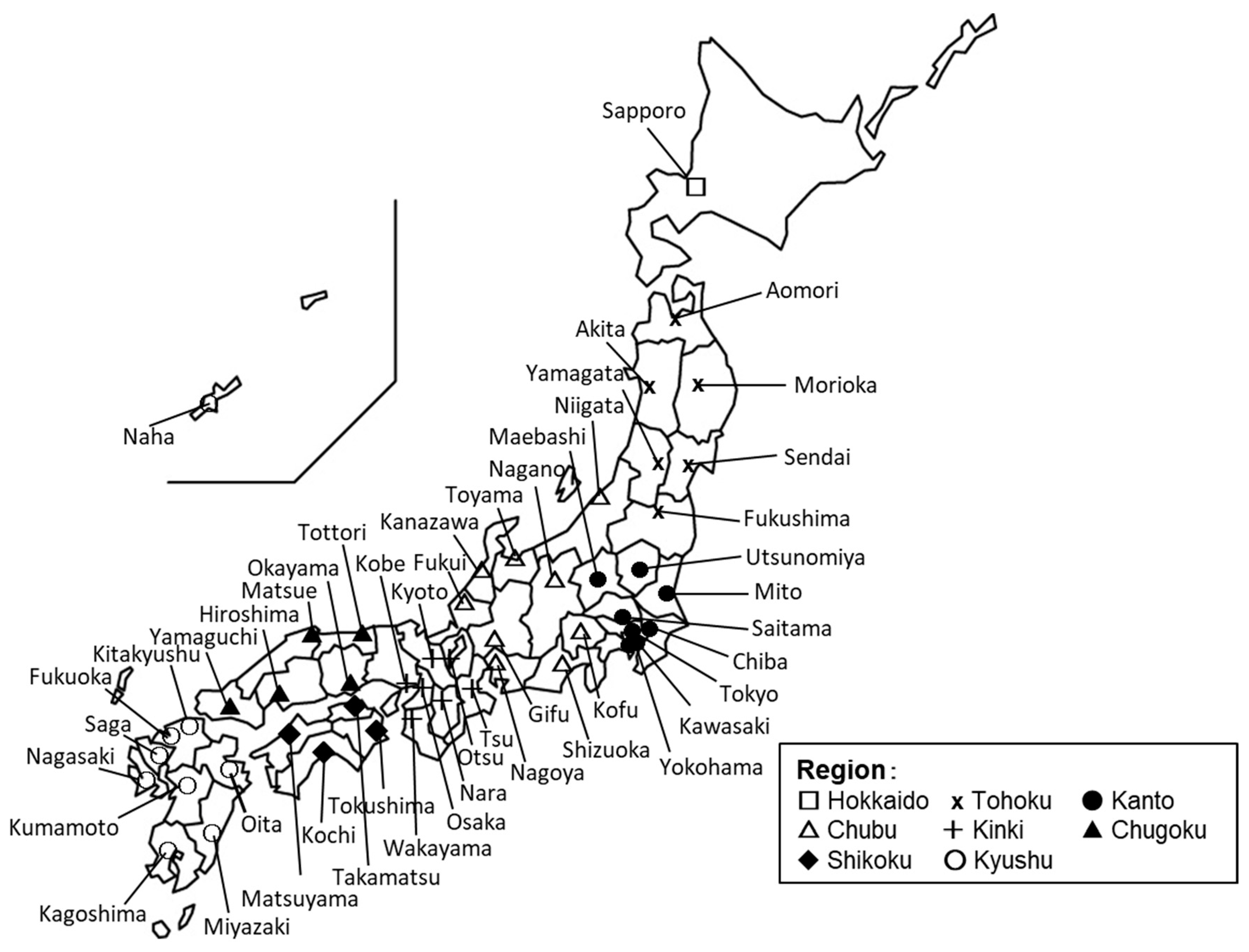
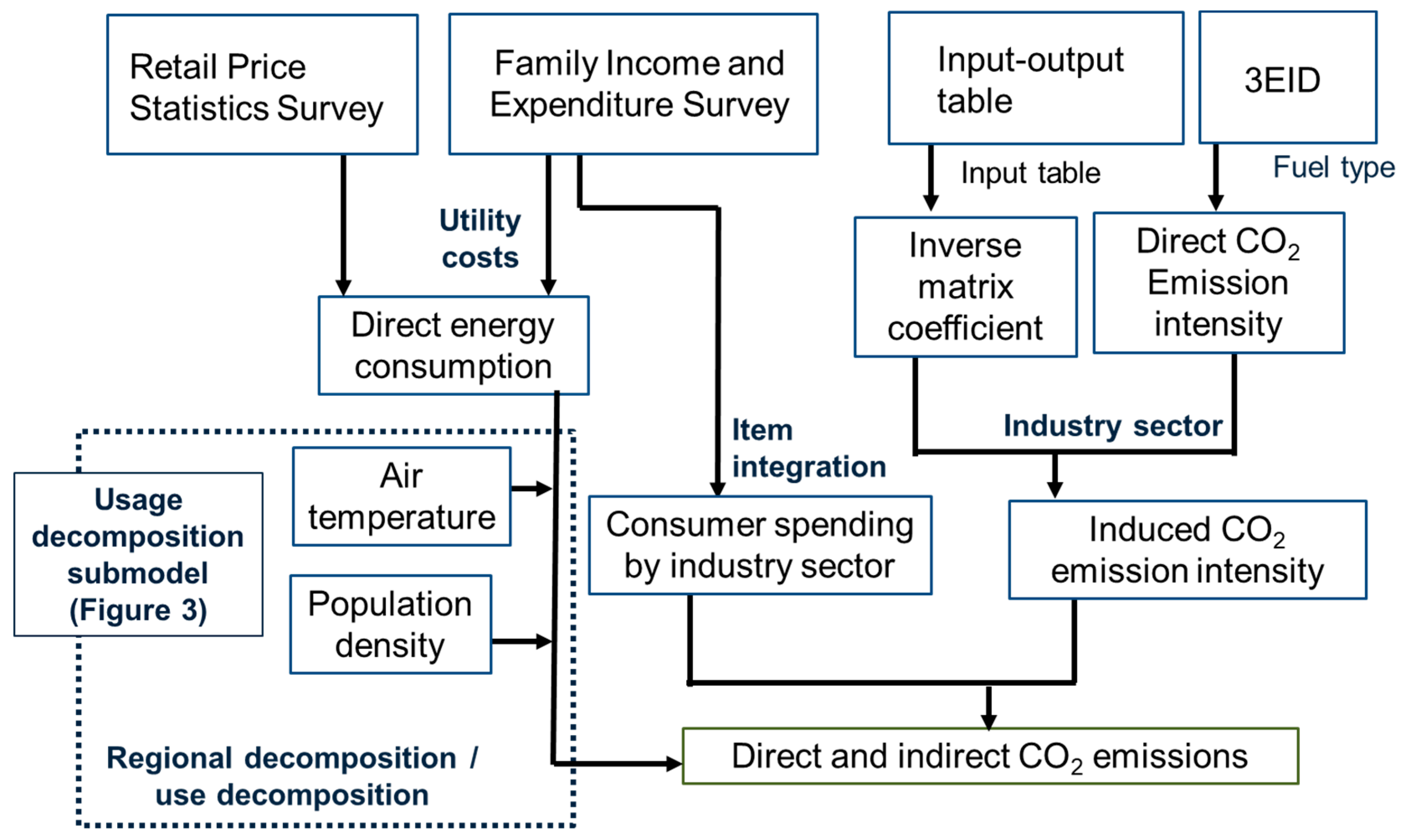
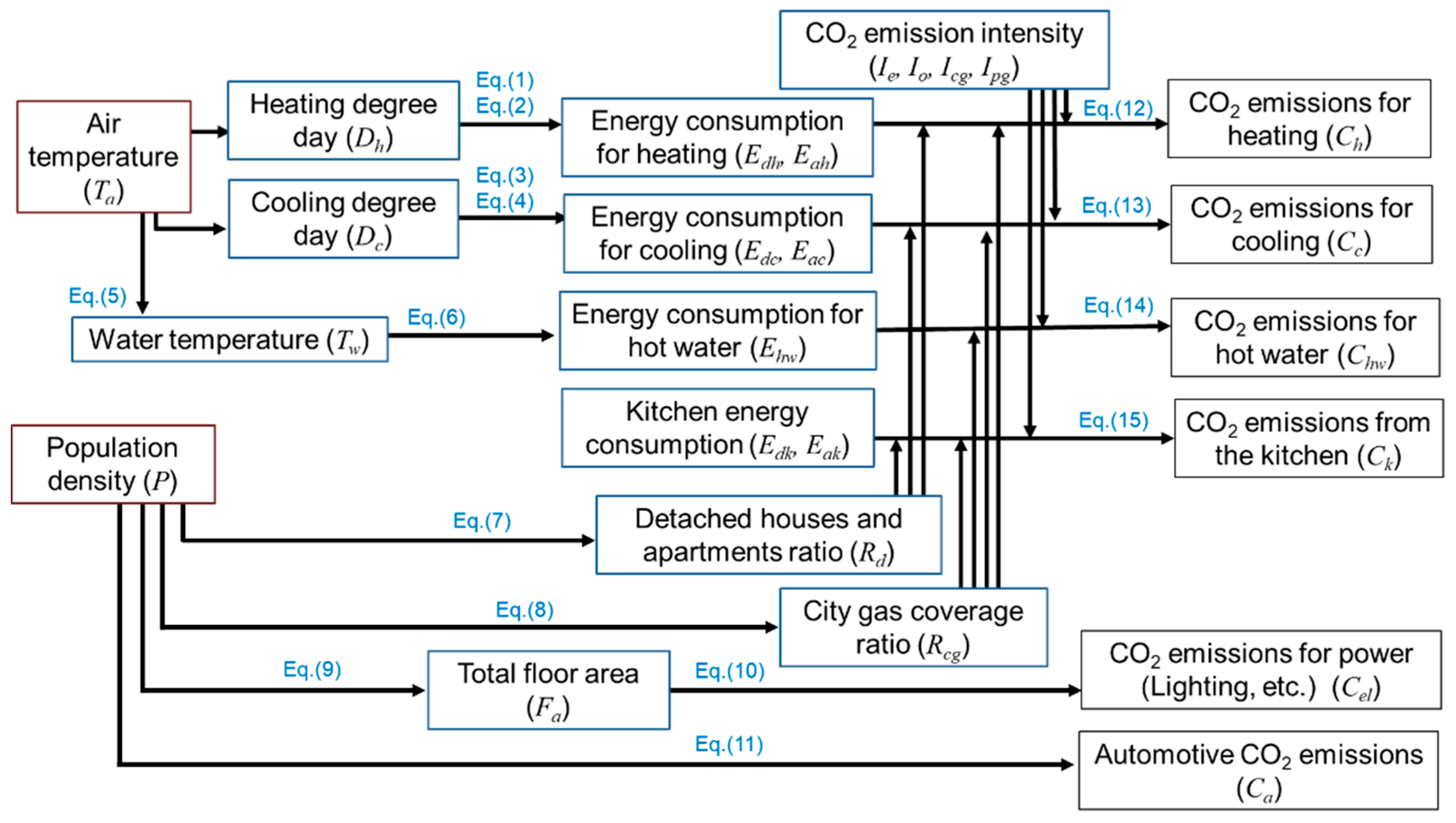


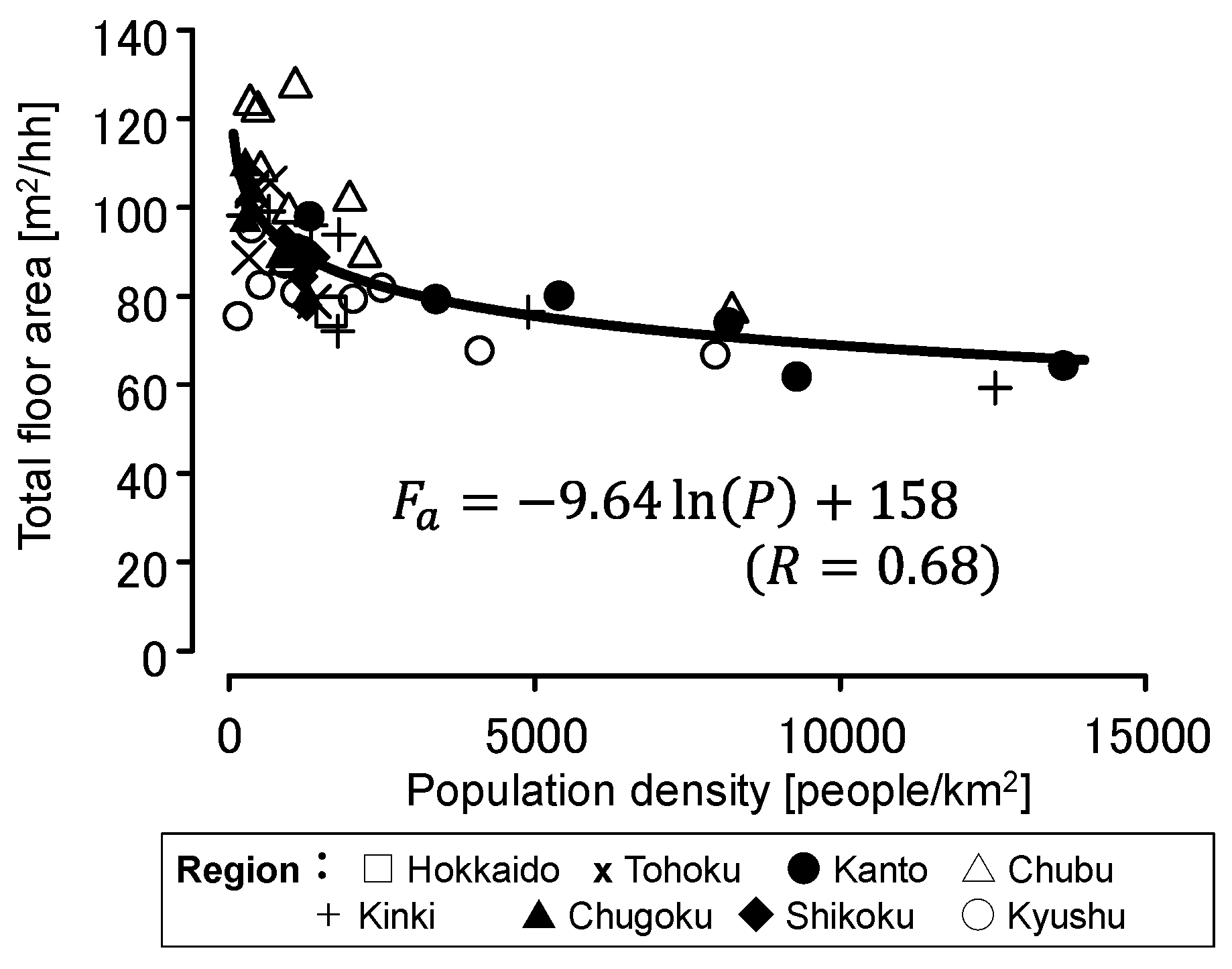
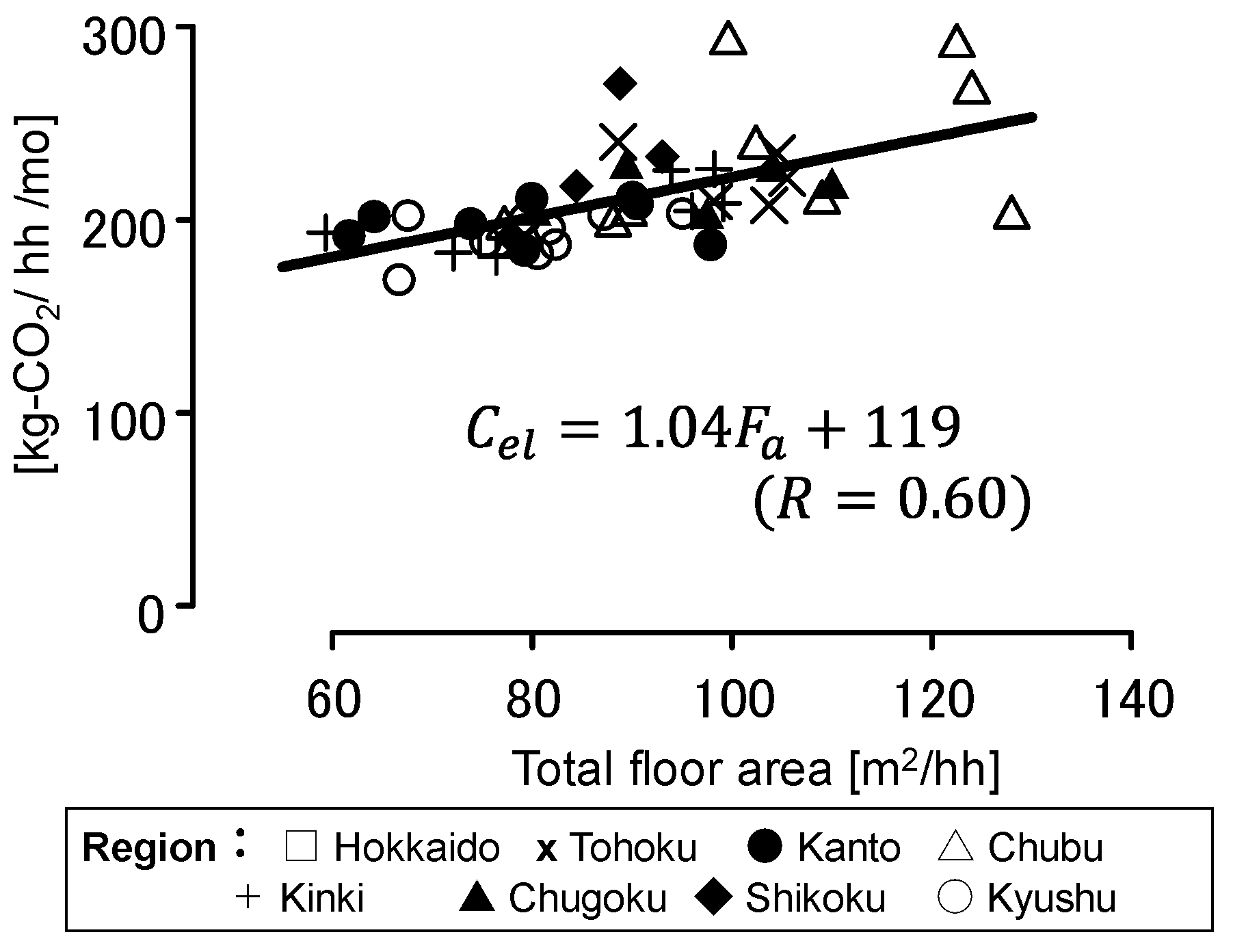
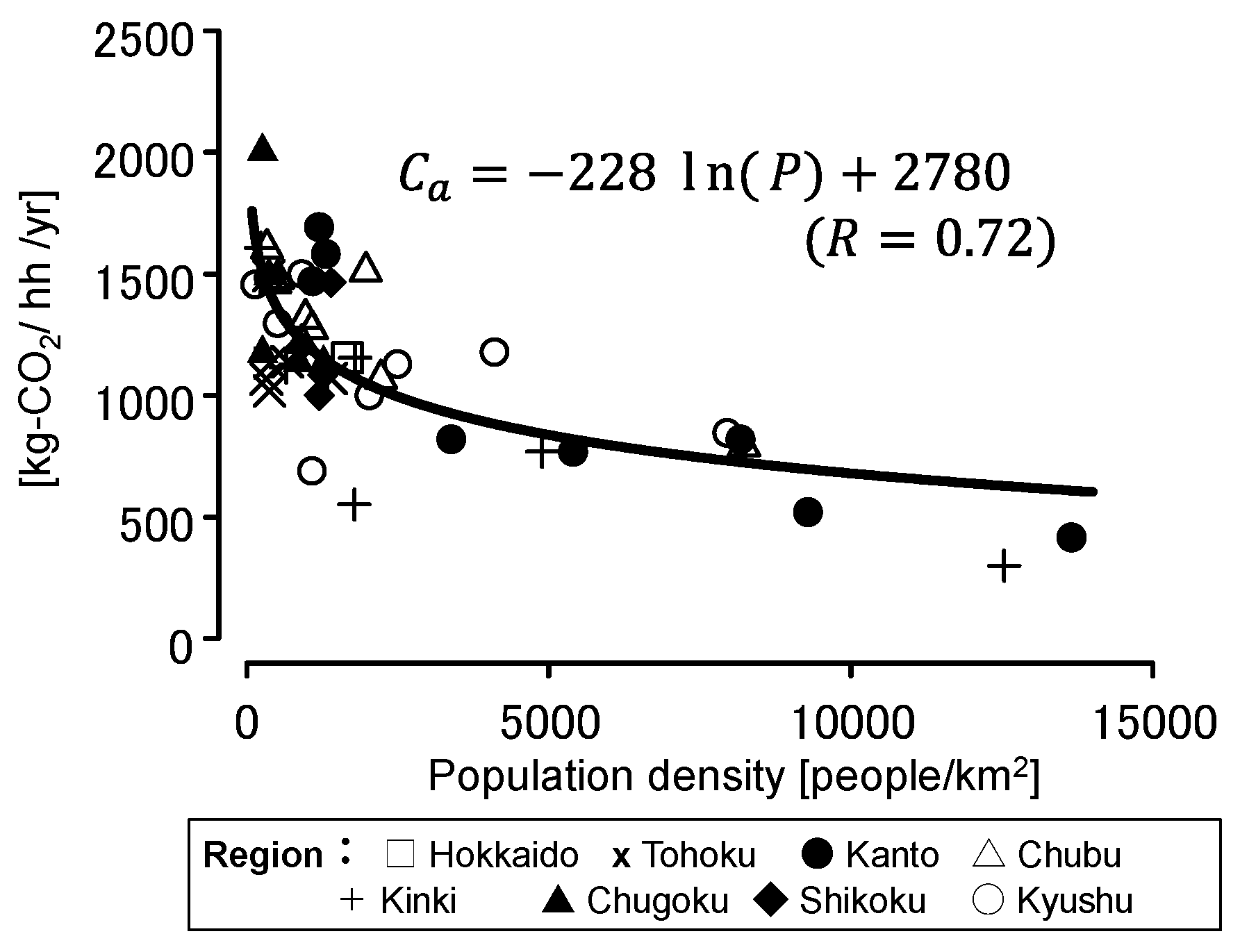


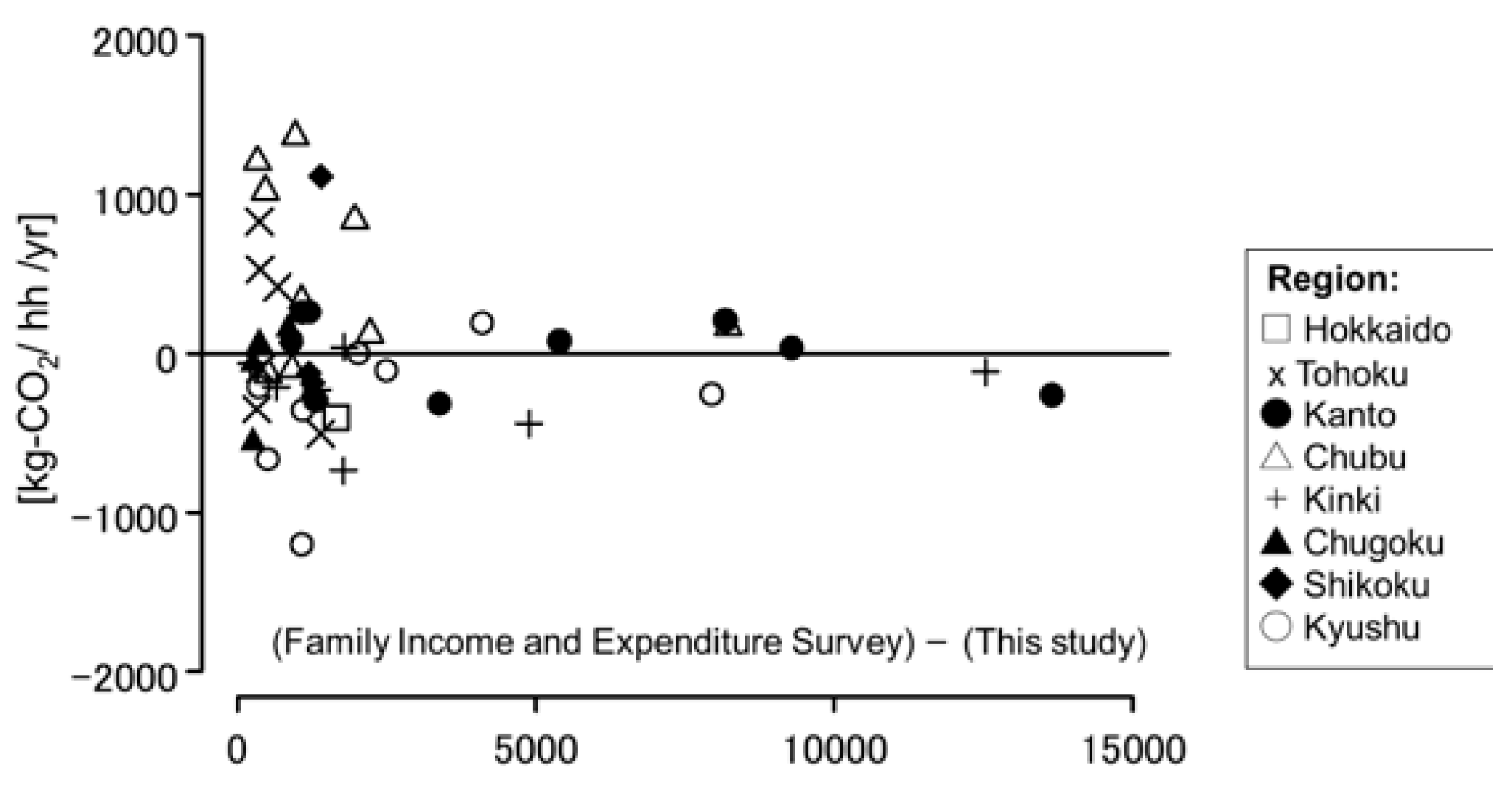
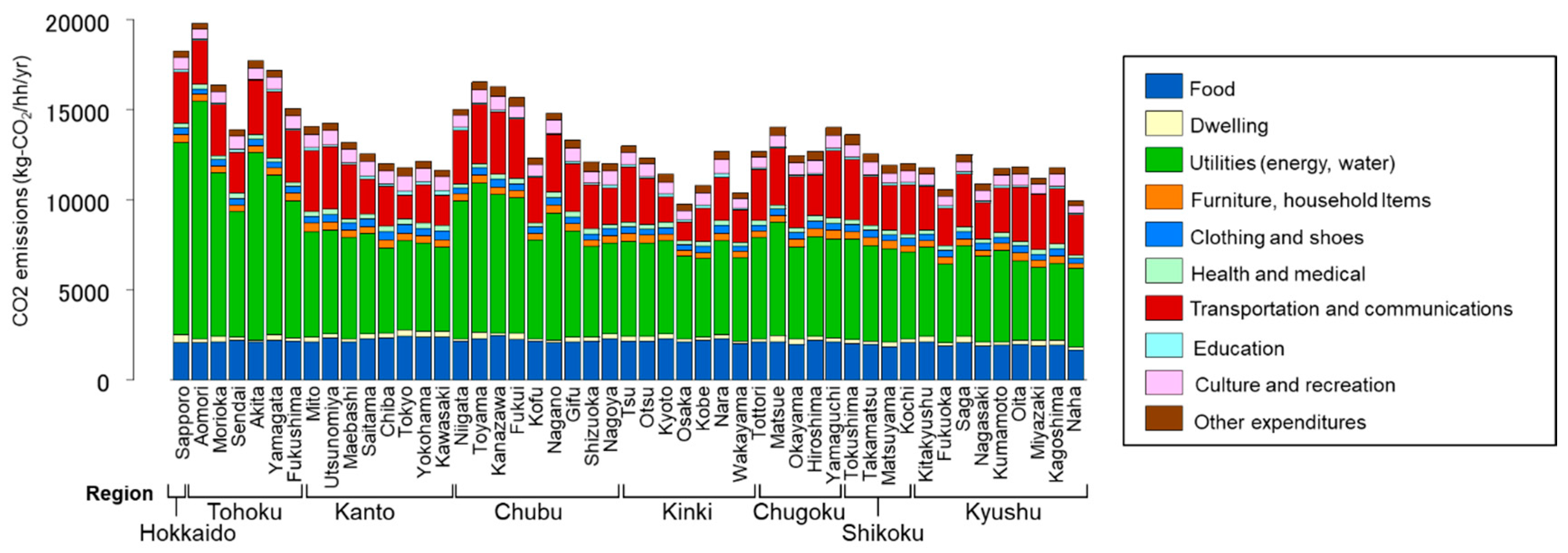
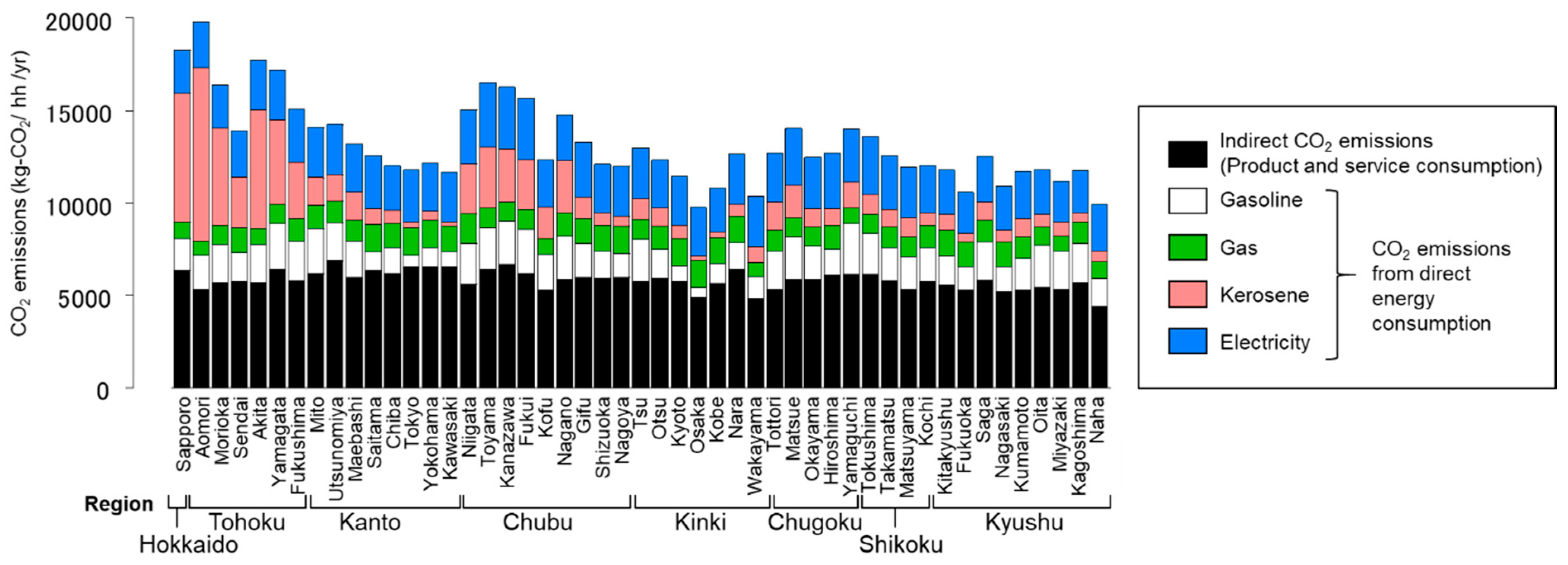
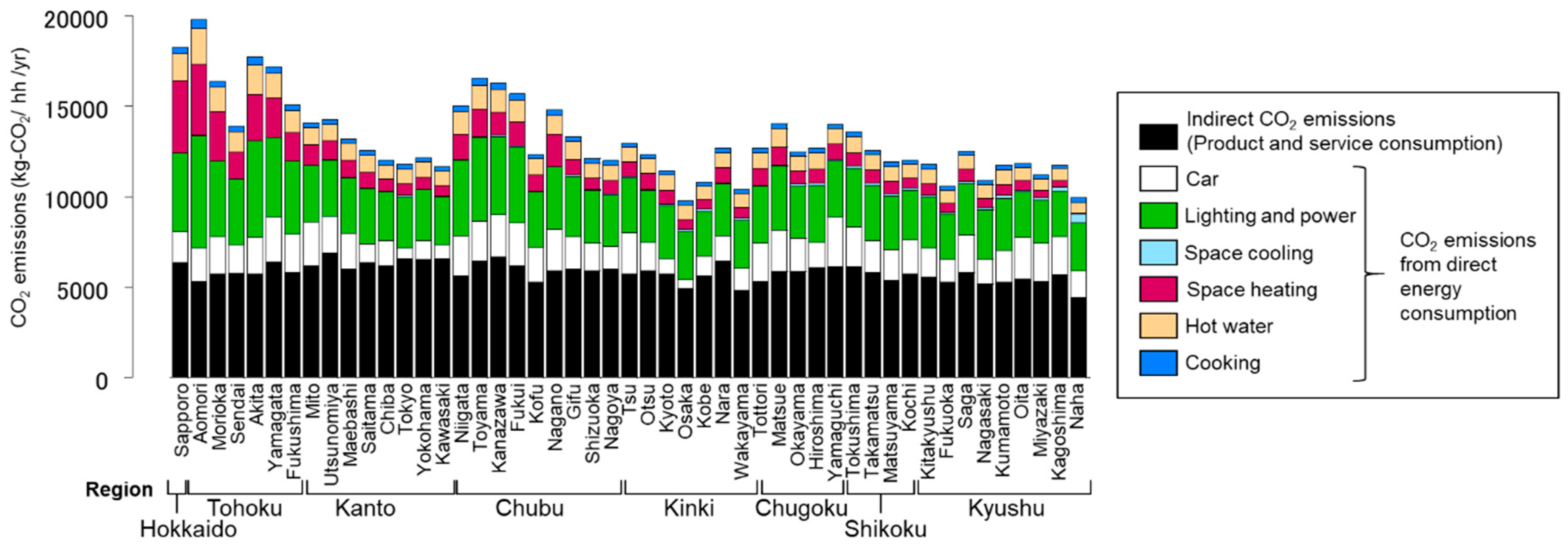

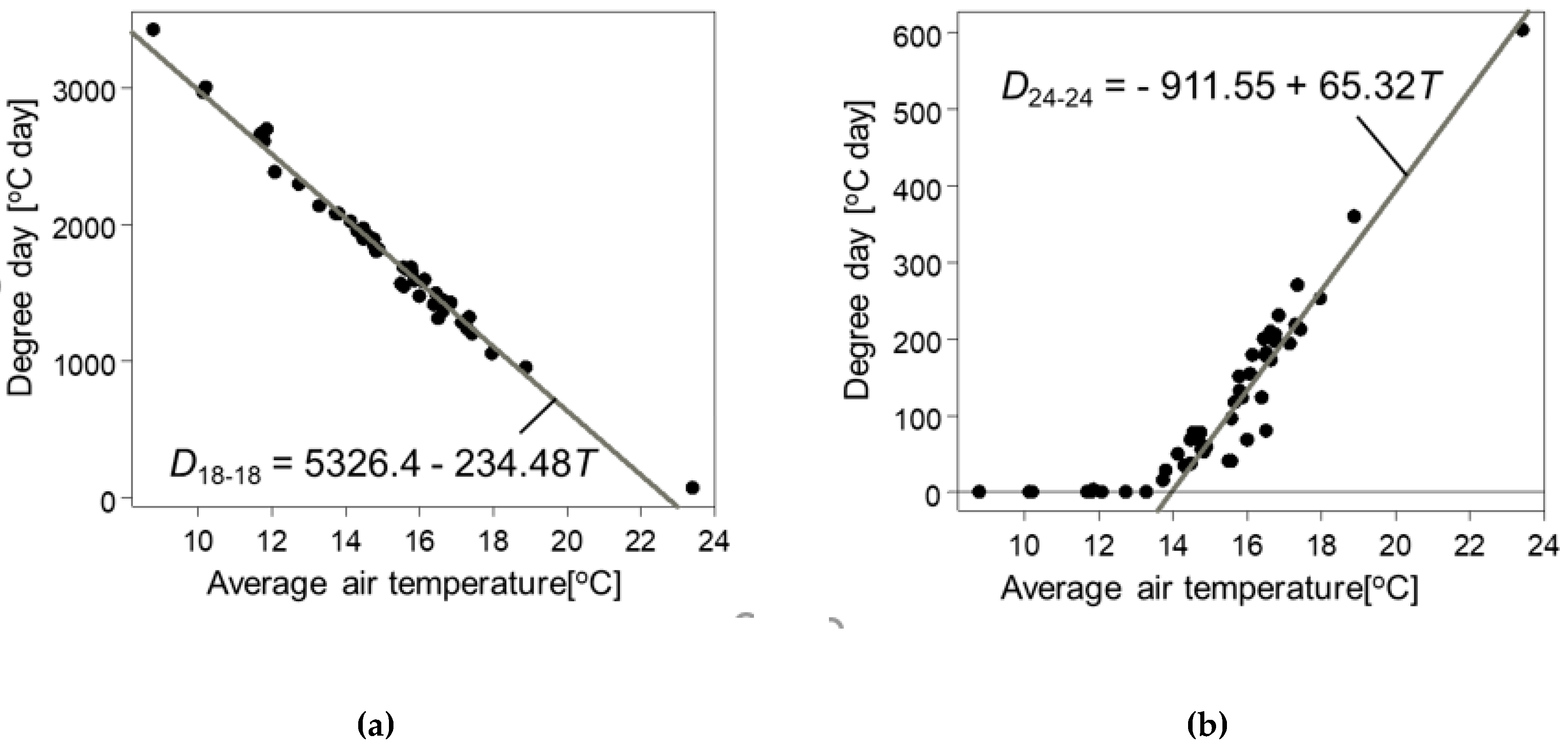
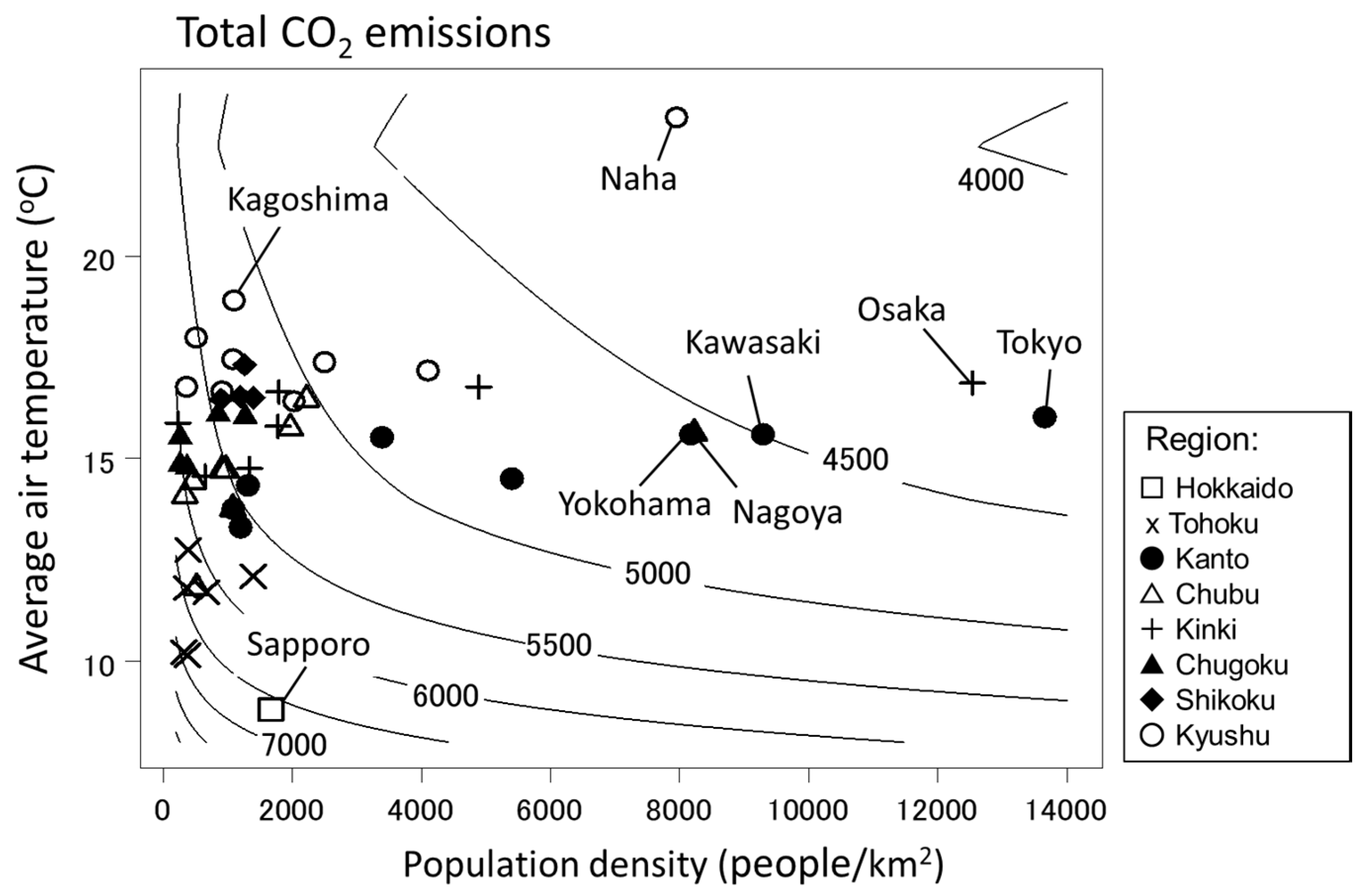

| Energy Applications | Households Using City Gas | Households Using LP Gas |
|---|---|---|
| Space heating | City gas: 30% Kerosene: 50% Electricity: 20% | Kerosene: 80% Electricity: 20% |
| Space cooling | Electricity: 100% | Electricity: 100% |
| Hot water | City gas: 100% | LP gas: 40% Kerosene: 60% |
| Cooking | City gas: 100% | LP gas: 100% |
| Energy Source | CO2 Emission Intensity (kg-CO2/MJ) |
|---|---|
| Electricity (secondary energy) | 0.1541 |
| Kerosene | 0.0678 |
| City Gas | 0.0511 |
| LP gas | 0.0600 |
© 2020 by the authors. Licensee MDPI, Basel, Switzerland. This article is an open access article distributed under the terms and conditions of the Creative Commons Attribution (CC BY) license (http://creativecommons.org/licenses/by/4.0/).
Share and Cite
Hirano, Y.; Ihara, T.; Hara, M.; Honjo, K. Estimation of Direct and Indirect Household CO2 Emissions in 49 Japanese Cities with Consideration of Regional Conditions. Sustainability 2020, 12, 4678. https://doi.org/10.3390/su12114678
Hirano Y, Ihara T, Hara M, Honjo K. Estimation of Direct and Indirect Household CO2 Emissions in 49 Japanese Cities with Consideration of Regional Conditions. Sustainability. 2020; 12(11):4678. https://doi.org/10.3390/su12114678
Chicago/Turabian StyleHirano, Yujiro, Tomohiko Ihara, Masayuki Hara, and Keita Honjo. 2020. "Estimation of Direct and Indirect Household CO2 Emissions in 49 Japanese Cities with Consideration of Regional Conditions" Sustainability 12, no. 11: 4678. https://doi.org/10.3390/su12114678
APA StyleHirano, Y., Ihara, T., Hara, M., & Honjo, K. (2020). Estimation of Direct and Indirect Household CO2 Emissions in 49 Japanese Cities with Consideration of Regional Conditions. Sustainability, 12(11), 4678. https://doi.org/10.3390/su12114678





